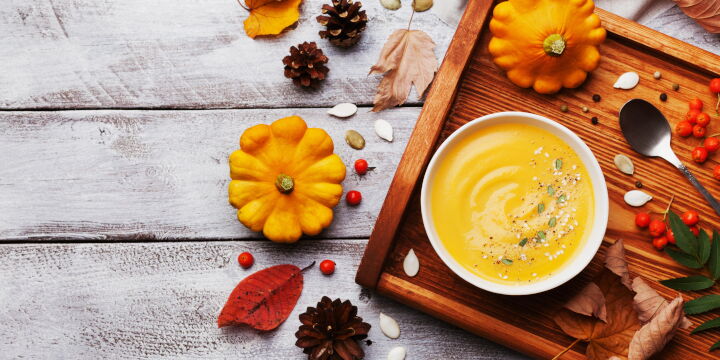Vitamins, minerals and its excellent nutritional values make pumpkin the vegetable to put in our shopping cart.
With her we fill up with vitamins and rebalance the intestinal flora!!!
Despite its sweet taste, pumpkin is a food with a very low carbohydrate and lipid content: 100g of product provide about 26 Kcal and make it perfect for diets aimed at weight loss.
Rich in water, fiber and mineral salts such as magnesium, zinc and potassium; this vegetable is also very rich in vitamins: group B, vitamin C and, of course, beta-carotene which gives it its characteristic orange color and is known to all for its antioxidant qualities.

Beta-carotene: powerful antioxidant that helps counteract the onset of free radicals and cellular aging
Rich in Omega 3, pumpkin is also an excellent ingredient to reduce cholesterol and activate a lowering of blood pressure thus reducing the risk of heart attacks.
Pumpkin: the ideal vegetable for those with constipation problems
The high proportion of fiber and water give it infinite beneficial properties for the intestine.
In fact, it favors a correct intestinal transit, managing to modify the consistency of the stool and activating itself for a rebalancing of all the flora.
Did you know that..
Is pumpkin the perfect ally for those on a diet?
The fibers contained in it help, in fact, to remove the sense of hunger making us feel full for longer.
Pumpkin: women's best friend
A lifestyle characterized by incorrect habits; unbalanced diet, sedentary lifestyle and lack of hydration can lead, over time, to accumulate fluids.
The pumpkin, due to the strong presence of water, is able to counteract this problem by freeing the body from the presence of toxins.

The vitamins contained in the vegetable also protect the hair and skin.
Furthermore, cucurbitine, an amino acid contained in it, has protective properties for the urinary system: the pumpkin seeds, which are rich in it, help to combat problems that often affect women; such as cystitis for example.
Pumpkin: a food that removes anxiety
The minerals that pumpkin is rich in and magnesium, in particular, have beneficial characteristics on the body and our mood.
The pulp of the pumpkin also consists of a rich percentage of tryptophan; the essential amino acid that works for the production of serotonin, the hormone that regulates the circadian cycle and known by all as the hormone of happiness.

Pumpkin seeds are a great ingredient to enrich your meals: try adding a spoonful of them for breakfast to your porridge along with the oat flakes and cook everything in milk.
Pumpkin in the kitchen
The positive notes that distinguish this vegetable make it an excellent food used, especially in these months, to make both sweet and savory recipes.
It is a versatile ingredient to be used both raw and cooked: it can be blended to obtain a puree and added to rice and it can even be used to prepare bread.
Make with us the soft Pumpkin chocolate chips cake or the Pumpkin spice latte the drink you would need in every corner of the city if you were in London at this time.
We have prepared it in the healthy version to make it also protein!!!
Sure you didn't know that..
1. In Mantova, the Italian city that consumes the most, seasonal pumpkin-based beer is produced in some breweries.
2. You eat everything from the pumpkin and throw away nothing: the peel, seeds, flowers and leaves!!!
3. 30 pumpkins are required to obtain one liter of pumpkin seed oil which lowers cholesterol and helps prevent heart and circulation problems.
4. Why do they say "don't have salt in your gourd?!"
This saying comes from the ancient Romans for whom salt had a great value: the basis of their heritage and index of wealth, it was used both as a condiment and as a currency.
The salt came from this people kept inside the pumpkins emptied of the pulp, left to dry and transformed into real coffers.
Therefore, those who, like in ancient Roman times, had little salt in their gourd and were therefore poor, today those who "have no salt in their gourds" are poor but of intellect.
This comparison with time arose spontaneously, simply, due to the visual similarity of a man's skull to the vegetable.
The pumpkin and Halloween: why is it its symbol?
In America it is one of the most anticipated parties by children who wander the streets of the neighborhood asking "trick or treat?!" and the custom of carving pumpkins has very ancient roots.
The practice of digging pumpkins is believed to originate in Ireland.

The Halloween party arrives, in fact, in America at the beginning of the 19th century when the Irish begin to emigrate, bringing their traditions to the USA including, in fact, this festival and their custom of carving turnips with the face of Jack O ' Lantern.
The turnip, however, was not available in America: since then only pumpkins to carve!!!
It really has no contraindications and its use, as we have seen, can only be positive.
Only trick: we use its seeds without exaggerating; they are the most caloric part of the pumpkin!
Sources:
www.inran.it/zucca
www.wikipedia.it/zucca
